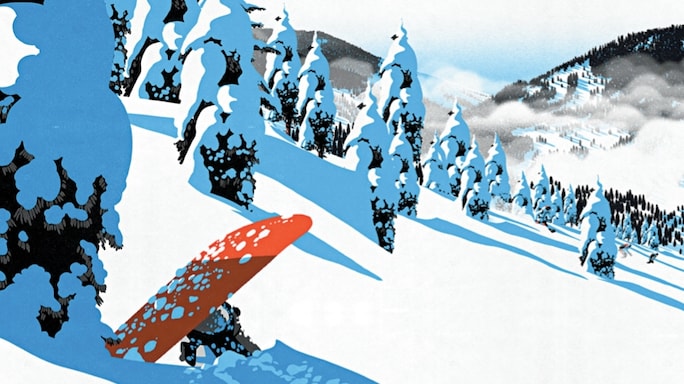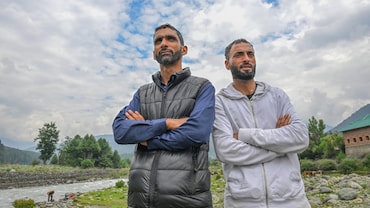Buried in a Snow Tomb
The snowboarder was off the trail, headfirst under six feet of powder. To survive, his luck would need to change
 illustrations by Timba Smits
illustrations by Timba Smits
Ian Steger was disoriented and scared. Of course he was. He was sprawled upside down in the dark, under more than 6 feet of snow, the weight of which was pressing down on his chest, making it a struggle to breathe what little air there was.
Steger was an athletic 40-year-old, but that didn’t matter. He knew there was no way to escape. A good friend had died just three months earlier in this exact situation. Steger accepted that he, too, was about to die.
His mind raced, full of images and regrets, of words and feelings he wished he had shared with friends and loved ones when he’d had the chance. Too late now.
He had no idea what suffocating to death felt like. He hoped it would be peaceful.
Steger grew up in Bellingham, Washington, about an hour or so from where he was now trapped in the Mount Baker Ski Area. When he was two years old and just learning to walk, his father had hauled him to the area and taught him to ski. He loved it, and he later took up snowboarding on the mountain.
His job as a real estate agent gave him a flexible schedule, the chance to hit the slopes whenever he wanted. He typically went to the ski area more than 30 times a year, and he made it a point to be there whenever storms dumped fresh powder. 3 March 2023, a Friday, was such a day.

The area is nicknamed Powder Mountain. Experienced skiers and snowboarders are drawn to the virgin powder outside the routes maintained by the ski patrol. The backcountry boundaries are marked by ropes and signs to warn people that they’re leaving the safe zone. ‘Safe’ is the operative word. Experts say skiing isn’t dangerous until it is. In 2022, more than 66,000 injuries were attributed to skiing and snowboarding, according to the National Safety Council, which reports that “excess speed, loss of control and collisions with stationary objects, like a tree or lift tower, are the most common factors associated with fatalities.”
Knowing that, those venturing beyond the ropes are expected to do so with a partner and to have avalanche gear, a two-way radio and a backpack with a shovel and snow probes.
Steger and his three buddies had all the required gear when they slipped under the ropes for their second run of the morning. They found great powder and the thrill of navigating through the trees. Blazing down the hill, they were aware of ‘tree wells’. These hidden dangers occur when low-lying branches hinder snow accumulation around trees, resulting in as much as 10 feet of loosely packed snow that can entrap a person, much like quicksand. And, like quicksand, tree wells often appear innocuous.
Digging yourself out of a tree well doesn’t have to be onerous. “We’ve all been there,” says Steger. “I’ve had to dig out a couple times. You reach down through the snow, find the board, unstrap it from your feet and pull yourself out of the hole.” That’s how it usually works, anyway.
On that Friday run, Steger’s friends were in front of him when Steger, moving through the trees, ran into trouble. The front of his board clipped a small branch hidden under a massive layer of new snow. Upended, Steger teetered before falling backward into a tree well.
The winter sports informational site deepsnowsafety.org has this advice for skiers who find themselves slipping into a tree well: Yell or use a whistle to get your partners’ attention. Do whatever you can to keep your head above the surface of the snow, including rolling your body and grabbing tree branches or the trunk. And if possible, keep your feet below your head.

Great recommendations, but not applicable in this case. Before Steger could call for help, grab a tree root or make sure his head was above his feet, he was upside down in deeper snow than he’d ever been in. All he could see was pitch blackness.
During avalanche-survival training, instructors tell students that the first thing you must do when trapped under snow is create an air pocket around your mouth. Steger remembered that from the basic training he had done years before.
One of Steger’s arms, however, was pinned next to his body, Luckily, his other arm had ended up next to his face, so he managed to push the snow away from his mouth, creating a small air pocket. To protect the pocket and prevent snow from falling in and covering his mouth, he grabbed the tip of his jacket and pulled the fabric over his face.
And now all he could do was wait. That’s what he had been taught. Stay calm and wait to be rescued.
Here, however, classroom theory and lectures had little to do with the nightmarish reality facing Steger. “All I could hear was the pounding of my heart,” he says. To stave off waves of panic, he focussed on breathing slowly and consuming less of the precious oxygen, while waiting for his friends to come get him.
He figured two or so minutes had passed. Then the two-way radio on Steger’s shoulder crackled with messages from his friends: “Where are you? … We didn’t see you come out of the trees … Let us know if you’re in front of us!”
He now knew that his friends were downhill from where he was stuck.
And because they surely assumed he’d passed them, he correctly assumed they weren’t likely to take off their snowboards and make the long, difficult trudge back up the hill to look for him. It would be up to Steger to get himself out. “If I didn’t,” he says, “I knew I was going to die.”
He remembered from his training that a person has about 15 minutes of air while buried in the snow before they suffocate and die. By now, Steger guessed he’d been trapped in his snowy grave for more than five minutes.
Once more, he summoned all his strength to try to wriggle free. Instead, he sank deeper into the snow. The pressure tightened around his chest, and he sensed the air pocket was collapsing.
Then came the dark thoughts. I’ll never see my fiancee again, he thought. They’d only been engaged for four months. She was the love of his life, but in some ways, he and Jordan Richardson were opposites. Her idea of being in the outdoors was walking the dogs.
He thought of Bill Kamphausen, his snowboarding friend who had died in late 2022 right here at Mount Baker Ski Area when he suffocated after falling into a tree well. Someone eventually spotted the tip of Kamphausen’s snowboard sticking out of the snow. They dug him out, but by then it was too late to save him.
After that, Richardson had hounded Steger to get their wills in order. They’d collected all the documents, and he remembered seeing the papers that very morning neatly stacked on the kitchen table. All they needed was his signature.
Steger thought of the aftermath of his friend’s death—the memorial, the mourning. Soon, it would all be repeated, but for him. Then came acceptance.
“There was no sense in freaking out,” he says. “I was not going to make it. I started breathing slow. I wanted it to be peaceful. I wondered how long it would take me to die.”
Then he felt his snowboard, still attached to his feet, move. He felt it again. Was he imagining it?

Francis Zuber, a 28-year-old carpenter who lives in Bellingham, had gone to Mount Baker Ski Area that Friday to chase powder. Since moving to the city in August from New York, he’d been a regular on the slopes.
“I saw a buddy on the chair lift,” he says. “He gave me a shout. We met at the top and decided to pop out-of-bounds. That zone was unfamiliar to me. I picked a random line and took off down the hill.”
As he sped down the slope, Zuber caught a glimpse of colour in his peripheral vision. “Something red,” he says. “I didn’t know what it was, but it was out of place and made me stop and turn around. That’s when I saw the upside-down snowboard in a tree well.”
It was just lying there as if someone had lost it. Then it moved. Someone was attached to that board.
Adrenaline surged through Zuber’s body. Determined to help, he unsnapped his skis, stepped out of them and immediately sank into the snow, all the way up to his chest. He was stuck. But he wasn’t powerless. He had run track in high school, so now he forced himself forward in a race where seconds counted.
Taking slow, powerful steps and using his arms in a breaststroke motion to push the heavy snow out of the way, he inched his way up the hill. Full exertion, no letting up, fearing that whoever was attached to that snowboard would die if he couldn’t reach him in time.
He took another slow step, his knee punching a hole in the snow. Then another step, again led by his knee while his arms swept snow away from his chest. This went on for a number of agonizingly slow strides until Zuber reached the well, where he used his hands to frantically and violently dig downward. The snow had the thick density that, in another place and time, would make a perfect snowman.
In the blackness, Steger—his oxygen running out—felt a hand on the outside of his jacket.
“I was tasting stale air,” he says. “Like when you put a blanket over your head and hold it tight and breathe in and out.”
Then, suddenly, the darkness began to lighten. His jacket moved away from his face. A hand pushed the snow away from his mouth. Cool, fresh air hit his face, and he sucked as much of it into his starving lungs as he could.
Standing over him, Zuber caught the sound of a gasp.
“Can you hear me?” he asked.
“Yes,” replied Steger.
“Are you all right?”
“Yes.”
“I’ll get you out in a minute.”
“Thank you.”
 “A good day,” Ian Steger, left, said after returning to the slopes with Francis Zuber. Photo Courtesy of Ian Steger
“A good day,” Ian Steger, left, said after returning to the slopes with Francis Zuber. Photo Courtesy of Ian Steger
Zuber unclipped an avalanche shovel and began digging with it, eventually seeing Steger’s legs, upper body, arms and then his face. Finally, he could grab enough of Steger to pull him free and help him stand beside what had almost become a cold grave.
Steger coughed up blood. The small air sacs in his lungs had been working so hard they had burst.
Both men looked at the blood on the snow. And then Zuber, the rescuer, as thrilled by what had transpired as Steger, the rescuee, wrapped him in a bear hug.
“You saved a life today,” Steger managed to say.
Steger radioed his friends to give them the good news. Relieved, they cheered and told Steger they were more than 300 feet downhill and would meet him there.
He and Zuber hugged once more, and then they went their separate ways, with Steger snowboarding down to his friends.
Those 10 or so minutes on the mountain changed both men. “It’s tough for me to sort the whole thing out,” Zuber admits. “Coincidence, divine intervention. Whatever you want to call it, it’s wild. As far as the existential stuff goes, I’m still trying to parse it all out.”
Ian Steger and Francis Zuber have kept in touch. They even routinely return to Mount Baker to hit the slopes together. “A friendship blossomed from all this,” Zuber says. “We’ve had some great times together.”
Steger, for his part, believes he’s been given a second chance. The experience “allowed me to realize what’s actually important in life,” he says. “I have a new appreciation to make the most of every single day, because you have no idea if it’s going to be your last day.”
He even signed the will.
First published in TheOregonian, 8 April 2023 © The Oregonian 2023.






